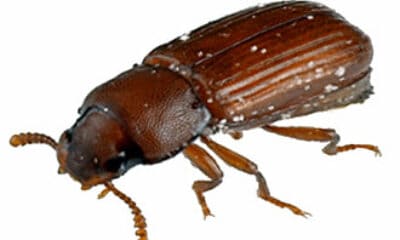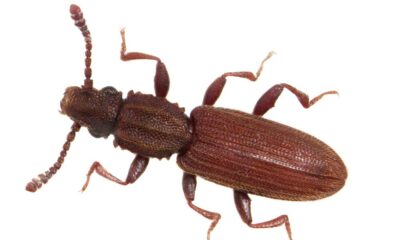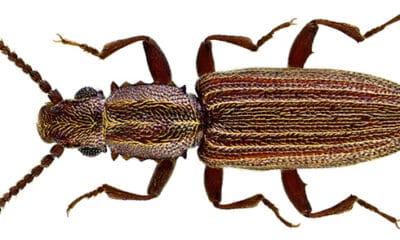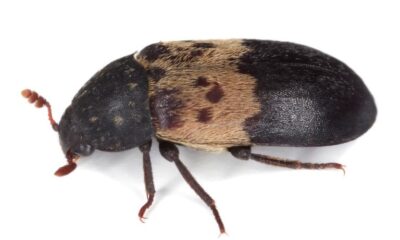
Stored Product Insects or ( SPI ) for short The main reason we control SPIs is the incredible damage and contamination they cause to foodstuffs, raw materials and finished products. SPIs not only eat these products, they breed in them and can spread quickly, contaminating a huge amount of product which is then unfit for human consumption. Contamination of foodstuffs is such a huge concern that there is an entire branch of forensic entomology dedicated to studying it. You can identify if you have a problem by using some of our bullet points below.
 Discoloration of food products, such as flour
Discoloration of food products, such as flour
 Damage to raw materials, tainting
Damage to raw materials, tainting
 Small holes in nuts or grains
Small holes in nuts or grains
 Live or dead insects, larvae, pupae or silken webbing
Live or dead insects, larvae, pupae or silken webbing
 Track marks in powder, flour or grain
Track marks in powder, flour or grain

STORED PRODUCT INSECTS
The Biscuit Beetle (Stegobium Paniceum)
The biscuit beetle is 2-3mm long and is dark-matt brown in colour. Biscuit beetles are often confused with furniture beetles/woodworm.
The biscuit beetle is found worldwide and is common throughout the UK & Ireland. It is found in shops and domestic larders infesting a wide variety of food stuffs such as such as flour, bread, breakfast cereals and other cereal products, beverage concentrates, spices, biscuits, packet soups and drinks.
Control Methods
The source of the infestation should be traced. Any affected foods should be discarded. The area should then be thoroughly cleaned, and a residual insecticide which is suitable for ‘crawling insects’ can be used.
Give us a call to sort any stored product infestations, use our contacts page.

Broad Horned Flour Beetle (Gnatocerus Cornutus)
The broad-horned flour beetle is 3-4 mm, flattened, parallel-sided and reddish-brown. Mandibles of males are highly enlarged and horn-like, with the sides of head having flange-like processes. The structure between the base of the front legs is parallel-sided and pointed at the tip.
The Broad-horned flour beetle, just like the majority of the stored product insects, is not dangerous to people or pets, however, the infested products should not be consumed.
Infestation Signs
The typical infestation signs of this flour beetle are similar to the ones of the other family members – development and accumulation of mould in the product with the increasing size of the infestation, as well as change of the product colour – it may change to grey. Other signs may be broken packaging and debris of the product found around the product pack.
Control Methods
- Use trapping methods to identify and measure insect infestations
- Clean stores thoroughly before harvest and seal all building cracks and crevices
- Store grain at 15 % MC and 15 C
- Where appropriate apply insecticides to the fabric of stores or apply grain protectants

Rust-Red Flour Beetle (Tribolium Castaneum)
Adult elongate, 2.3 – 4.4 mm in length; colour, reddish-brown; antennae with distinct, 3 – segmented club at tip; no ridge present above each eye.
The Broad-horned flour beetle, just like the majority of the stored product insects, is not dangerous to people or pets, however, the infested products should not be consumed.
Infestation Signs
Beetles attack milled grain products such as flour and cereals. These beetles often hitchhike into the house in infested flour and can build up into large populations on food accumulations in cabinet cracks
and crevices and in furniture. The life cycle requires one to four months when temperatures are favourable and the female may live for as long as 2 years.
Control Methods
Control of these pests begins with a thorough inspection, source the location and then the destruction of the infested food. Within commercial situations, the use of insect monitors is key to help pinpoint the infestations. A thorough clean up is advised, using a vacuum cleaner to get into the cracks and crevices followed by a treatment using a broad spectrum residual insecticide.

Confused Flour Beetle (Tribolium Confusum)
The confused flour beetle was named because of the confusion over its identity. The red flour beetle is named after its rust-red color. The two can be easily separated based on antennal characteristics. The antennae of the red flour beetle is distinctly club-like, with a three-segmented club. The club of the confused flour beetle antennae is four segmented and forms the club gradually. Another slight difference is in the shape of the thorax. The sides of the red flour beetle are curved, whereas the thorax of the confused flour beetle is straight. Both species are cosmopolitan in their distribution. Adult beetles are approximately 3.5 mm (1/7”).
Larvae of both species are nearly indistinguishable. They are a light honey color and about 6 mm (1/4”) long. The head and a distinctive forked process at the tip of the abdomen are slightly darkened.
Infestation Signs
Flour beetles can be found infesting a variety of grain and food materials. They have been reported from grain, flour, and other cereal products, beans, cacao, cottonseed, shelled nuts, dried fruit, dried vegetables, drugs, spices, chocolate, dried milk, animal hides, herbarium and museum specimens. They cannot feed on whole grain, but can feed on broken kernels that are usually present. In general, fungi may play a significant role in the nutrition of flour beetles.
Control Methods
Control of these pests begins with a thorough inspection, source the location and then the destruction of the infested food.

Flat Grain Beetle ( Cryptolestes Pusillus )
The Flat Grain beetle is part of the ‘bran bugs’ family. This family consists of the Flour mill beetle, the Rusty grain beetle and the Flat grain beetle. Similarly to the other stored product insects, the Flat grain beetle can be found in places, where cereals are stored, as well as foods such as flour, wheat, dried fruits, nuts, barley, rice, corn, etc… This pest can also be found infesting products like chilies and cassava root, which is typical for Latin America and parts of Africa but have been imported into the UK and Ireland.
The Flat grain beetle is not considered dangerous to people or pets, however, the food infested by the pest should be disposed of. This stored product insect may cause nuisance in residential properties, whereas in a commercial warehouse or industrial grain storage it may result in a significant loss of business.
Infestation Signs
The typical signs of the Grain beetle infestation are damaged or mouldy kernels of stored products, where the larvae of the beetle is normally feeding. Broken product packages or tiny holes in them should alert you for the possible presence of a stored product pest. It is possible, although not very likely to find a Flat grain beetle feeding on whole kernels as they prefer the damaged or broken ones.
Control Methods
A Flat Grain beetle infestation can be eradicated if it is spotted at an early stage. For commercial premises, regular checks would prevent the occurrence of the infestation in the first place or, in case one has developed, they will help to reduce the amount of damaged products.
For domestic premises, regular cleaning of the kitchen and the areas, where stored products are kept, as well as sanitisation and regular checks of these products. All newly-brought products should be checked and placed into a glass jar with a lid, so that any access of the pest can be limited.

Saw Toothed Grain Beetle ( Oryzaephilus Surinamensis )
Adults are 2.5 mm (1/10 inch) long. The body is very flat and is well adapted for crawling into cracks and crevices. They are very easily identified. The margins of the thorax are saw-like and posses six projections on each side. In addition, there are three longitudinal ridges on the top surface of the thorax. A tooth on the femur of the hind leg separates the male from the female. Wings are well developed but there is no record of this insect flying.
Infestation Signs
This beetle can be found feeding on cereals, dried fruit, bran, rolled oats, brown rice, walnuts, breakfast foods, macaroni, sugar, drugs, fried meats, chocolate, tobacco, and snuff. It cannot attack perfectly sound grain, but can feed on slightly damaged grain. Thus, it is often found in whole grain in association with other insects. It has been observed feeding on eggs and dead adults of stored-product moths.

Merchant Grain Beetle ( Oryzaephilus Mercator )
Merchant grain beetles are typically not found in grain products, but instead like to attack cereals, cake mixes, macaroni, cookies and chocolate. Merchant grain beetles are dark brown and have six saw-like teeth on each side of their bodies. They can grow to be one-eighth of an inch long and have very flat bodies.
Infestation Signs
Although broken kernels are the preferred food of both species, sound kernels will sometimes be penetrated and fed on. The dry weight of grain may be reduced, but total weight may increase because of water absorption caused by the metabolic processes of insect populations. Moulds may begin to grow on the grain, further reducing grain quality and value.
Control Methods
Prevention is the best strategy to avoid insect problems in stored grains. Proper bin sanitation before introduction of new grain minimizes the need for pesticides. Good sanitation involves the removal of old grain and dust in and around the grain bin/silo. This includes removal of old grain from corners, floors, and walls. Any grain remaining when a bin is emptied can harbor insect infestations which will move into the new grain. Grain that is to be stored for longer than six months may need a protective application of an approved insecticide.
Grain placed in a clean bin should be checked at two week intervals during warm months and at one month intervals during cooler months for the presence of hotspots, moldy areas, and live insects. If any of these conditions exist, the grain should be aerated to lower the moisture level and temperature.

Larder Beetle ( Dermestes Lardarius )
A relatively large (7-10mm) oval beetle, almost black but with a distinct pale band across the front of the wing-cases. The larvae are white after first hatching, but turn brown and are covered with tufts of bristly hair. They grow to 10-12mm long and occasionally tunnel into soft wood to pupate. The life cycle takes about three months.
Infestation Signs
Larder Beetles are typically associated with materials with a high protein content, for example hides, skins, feathers, bones, dried meat, fish meal and dog biscuits. They are scavengers associated in nature with carcasses and bird’s nests but can be encountered and may be widespread in manufacturing and storage premises handling animal products, intensive poultry units, piggeries and domestic premises.
TIPS FOR CONTROL
-
Discovery of infested food items or other sources of infestation (e.g., food spillage accumulation) is the first step to control. The larder beetle is associated with a moist protein source or accumulations of dead insects.
-
Once discovered, the source will need to be removed or a residual treatment applied into the void to kill the beetles and larvae feeding on the source.

Yellow Mealworm Beetle (Tenebrio Molitor)
The Yellow Mealworm beetle is the largest among the stored product insects. It is a post-harvest pest, which is popular across farmers all over the world. It is a scavenger of damp and decaying cereals and grains, kept in wet and non-ventilated areas.
Typically, the Yellow Mealworm beetle settles in areas, where it is least disturbed. Sometimes this pest hides outdoors under storage bins, in and around chicken houses and sparrow’s nests, under sacks and other containers, where feed is stored. Inside premises this pest can be found in kitchens and dark areas, where the following products are kept: cereals and flours, cake mixes, bran, corn meal, meat scraps, etc.. Other places, where the beetle can hide are under old carpets and in straw chairs, kept in wet conditions.
The Yellow Mealworm beetle is a strong flyer and it is attracted by night lights. This makes it easy for it to infest properties during the summer season, when we tend to leave the windows open more often during the late hours of the days and the evenings.
Infestation Signs
The signs of a Yellow Mealworm beetle infestation are usually the larvae and the adult beetles, which can be seen in the infested products. The eggs are relatively small and bean-shaped, usually white in colour, so they may be difficult to spot. However, the damp environment and the presence of decaying grains or cereals, together with the larvae and/or the adult beetle form, would certainly mean that there is a presence of a Yellow Mealworm beetle infestation.
Control Methods
Make sure there is no presence of humidity or damp areas in homes or business premises.
For commercial customers it is important to keep cleaning and sanitisation at high levels as this pest can easily settle into old product bins and dark secluded corners, where they will not be disturbed.

Australian Spider Beetle (Ptinus Tectus)
Australian spider beetles arrived in Ireland and the UK from Australia in around 1900, and can now be found more or less everywhere. They are general scavengers and will feed on a variety of items including cereals, seeds, flour, meat, dried fruits and vegetables, fish food, dead insects, rodent droppings and old wood. Common sites of infestation in the home include wall voids and drop ceilings, as the infestation usually originates in a birds nest.
The female lays about 100 opalescent, sticky eggs, singly or in small groups, over a period of 3 to 4 weeks. Food and debris adhere to the eggs. The fleshy larva (which can grow up to 1/8 inch long), covered with fine hairs, is strongly curved, cream coloured and rolls up into a tight ball when disturbed. It can chew its way through sacking, cellophane, or cardboard, and can hollow out a chamber in adjacent woodwork when making a place in which to pupate. Pupation takes place in a tough, spherical, thin-walled cocoon. The adult may remain in this cocoon as long as 3 weeks after emergence. The average total lifespan of an Australian spider beetle is 12 months.
Infestation Signs
The signs that can alarm you for the presence of Australian Spider beetle infestation at your domestic or business property would be small cage-like formations on cardboard or wooden boxes or elements around a food source. It is in these cages that the the pupal stage of the insect develops. Found in damp and dark areas, the larvae of pest can chew their way through cellophane, cardboard and can bore in wood to make a cage for it to pupate in.
Control Methods
The source of infestation should be traced and eliminated. Old bird’s nests should be removed and destroyed. Good housekeeping and hygiene practices should be put into place, such as checking food items and ensuring that food areas are kept clean. A regular spray treatment may be required near wall / floor junctions with a residual insecticide over a period of about three months. However, the spray will only kill the adults and the larvae but it doesn’t kill the egg or the pupae, so repeated treatments are likely to be required.

Golden Spider Beetle ( Niptus Hololeucus )
The golden spider beetle, is so called from its golden yellow, silky hair and its spider like appearance. The beetle has a preference for dark moist places and will occasionally infest textiles. It will migrate and can be found in dark areas often in considerable numbers. Although it increasingly common in domestic premises this beetle is not harmful to health.
Adults have a large globular abdomen, narrow thorax (the central part of the beetle) and rounded head with long segmented antennae. They have a body length of 3-4.5mm and its upper thorax and elytra (wing case) are entirely hidden by golden yellow hairs. They have long thin legs.
The larvae are yellow-white grubs with a brown head and a curled c-shape. You will rarely see the beetles during the day as they are nocturnal and spend the day in dark cracks and crevices.
Prevent Infestation
To help eliminate an infestation, food should be kept in damp free and ventilated cupboards. Regularly clean your food storage units and remove any disused or old food. Cracks and crevices, which may provide harborages for the beetles, should be kept to a minimum. It is also important to ensure that there are no food residues.

Cigarette Beetle ( Lasioderma Serricorne )
Adult cigarette beetles are oval in shape and are yellowish-brown to reddish brown in color; they can grow to be 1/10th of an inch in length. Cigarette beetles have serrated antennae and have wings; they are fairly strong fliers. Their heads are bent downward giving their bodies and overall humpbacked appearance. The larvae of the cigarette beetle are off-white in color, smaller than the adult and have a worm-like appearance.
Detect Infestation
Appropriately named, cigarette beetles attacks tobacco wherever it is stored. Like other stored products pests, cigarette beetles also infest paprika, dry dog food, beans, biscuits, cottonseed, dried fruits and vegetables as well as dried flowers, grains, herbs, peanuts, rice, yeast and even furniture stuffing.
What Kind Of Threat Do Cigarette Beetles Pose?
The cigarette beetle does not carry any known pathogens, but a large infestation of these pests can cause serious problems for a food processing facility.
Cigarette beetles do not bite, sting, or transmit any known diseases. Cigarette beetles are mostly considered to be nuisance pests, but can cause damage to items found inside of homes as they live and feed.
Cigarette beetles will damage items like books, book bindings, dry flowers, wreaths, and stuffed furniture. They will also contaminate food that is being stored in your home, food items that they invade include: pasta, flour, seeds, dried fruit, dried fish, and dry seasonings. Cigarette beetles are also known to feed on pyrethrum which is an active ingredient that is found in insect baits and insecticides.
How Do I Control Cigarette Beetles?
Because cigarette beetles are found in our food supply, only properly trained professionals should treat infestations. Also, do-it-yourself pest control treatments and products may be harmful to people and pets if misused or mixed improperly.
